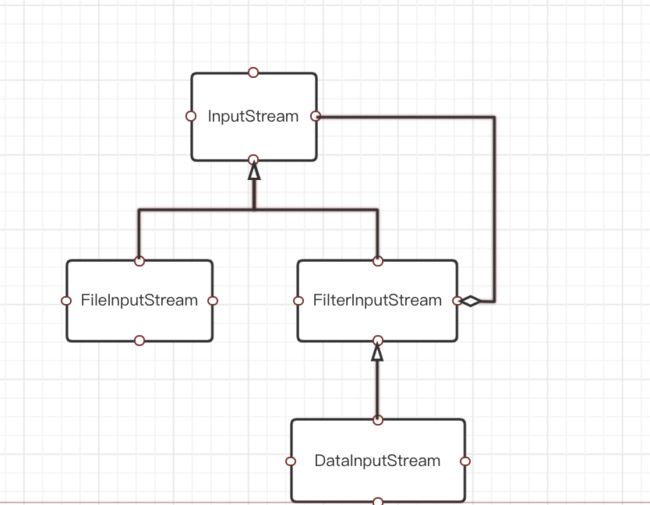最近打算把Java网络编程相关的知识深入一下(IO、NIO、Socket编程、Netty)
Java的I/O建立于流之上。输入流读取数据、输出流写入数据
输入输出流
输入流
输入流InputStream的API如下:
public abstract int read() throws IOException;//-1 到 255
public int read(byte b[]) throws IOException
public int read(byte b[], int off, int len) throws IOException
public long skip(long n) throws IOException
public int available() throws IOException
public void close() throws IOException
read()方法返回的实际上是一个无符号byte(Java中没有无符号byte类型, 就直接用int作为返回值了)
read方法返回-1时代表已经读完数据(如果是网络通信的话就代表对端不会再发送数据)
输出流
输出流OutputStreamAPI如下:
// OutputStream接口定义的几个方法
public abstract void write(int b) throws IOException;
public void write(byte b[]) throws IOException
public void write(byte b[], int off, int len) throws IOException
public void flush() throws IOException
public void close() throws IOException
write(int) 方法实际写入的是int的低8位(一个字节)
尽量不要使用write(int), 因为每次发送一个字节效率不高(每个TCP报文都至少有40个字节的网络传输开销, 每次传输数据太少的话信道利用率不高)
flush() 将缓冲区中的内容刷到底层输出流
关闭流
流对应了底层的文件句柄和端口, 所以使用完成之后一定要关闭
下面是常见的一种关闭流的写法(把流的关闭放在finally语句块中),但是可太复杂了!!!
FileInputStream in = null;
try {
in = new FileInputStream("/tmp/axt.t");
//
} catch (FileNotFoundException e) {
//
} finally {
if (in != null){
try {
in.close();
} catch (IOException e) {
//
}
}
}
简洁一些的写法
try(FileInputStream in = new FileInputStream("/tmp/a.txt")){
// do somethind
} catch (Exception e) {
//
}
因为Java会对try块中申明的所有AutoCloseable类型的对象自动调用close()方法,不需要手动调用!
过滤器流
过滤器流实际上是对流功能的增强,使用的是装饰模式。
装饰模式
装饰模式就是在原有的基础上增加了一些新的功能,通过组合实现。
下为过滤器流类结构--装饰模式的体现
过滤器流的作用
下面这段代码对FileInputStream 使用了 BufferedInputStream 和 DataInputStream 进行包裹
使得用户可以直接读取字符, 且是从Java缓冲区中获取(如果缓冲中没有可用数据,再尝试从底层输入流读取)
FileInputStream in = new FileOutputStream("/tmp/a.txt");
in = new BufferedInputStream(in);
in = new DataInputStream(in);
in.readChar();
过滤器流还可以实现解压(ZIPInputStream)、Base64解码(Base64InputStream)等,也可以自定义过滤器流以实现特定功能)
缓冲流
缓冲流作为过滤器流中的一种, 在网络通信场景下使用缓冲有利于提升发送和接受数据的效率。
所以在发送数据时我们应该使用BufferedOutputStream, 这样写数据时会先写入到java的缓冲区中, 缓冲区满或者调用flush方法时才会真正的发送数据,能够提升性能(提升信道利用率)
OutputStream out = new FileOutputStream("/tmp/a.txt");
BufferedOutputStream outputStream = new BufferedOutputStream(out);
out.write(1);
out.flush();
数据流
缓冲流作为过滤器流中的一种,提供直接读写Java基本类型的API
OutputStream out = new FileOutputStream("/tmp/a.txt");
DataOutputStream dataOutputStream = new DataOutputStream(out);
dataOutputStream.writeChar('c'); //写字符
dataOutputStream.writeUTF("ssss"); //写字符串
阅读器和书写器
提供读写字符的API(如果只是ASCII编码, 直接使用字节流即可)
书写器
OutputStreamWriter 提供直接读取字符和字符串的能力
OutputStream out = new FileOutputStream("/tmp/a.txt"); //底层字节流
Writer writer = new OutputStreamWriter(out, StandardCharsets.UTF_8);
writer.write("哈哈哈");
缓冲书写器
BufferedWriter 提供一层写缓冲(作用类同字节流的BufferedOutputStream)
Demo
OutputStream out = new FileOutputStream("/tmp/a.txt"); //底层字节流
Writer writer = new OutputStreamWriter(out, StandardCharsets.UTF_8);//书写器(编码)
writer = new BufferedWriter(writer, 1000);//缓冲书写器
for (int i = 0; i < 128; i ++){
writer.write(i);
}
writer.write("哈哈哈哈哈");//写汉字, utf-8编码可见,如果是ascii编码会乱码
writer.flush(); //这里其实不用flush, close之前会flush,但是最好有。
writer.close(); //close流, 释放底层资源。
总结
总体分成两类 字节流 和字符流, 字符流是仅对字节流的装饰(或者说字符流的底层就是字节流)
过滤器流:对基础流增加一些额外的功能 如果缓冲、压缩、加密等
缓冲流:读写数据中间加一层缓冲区,提升数据传输效率。
